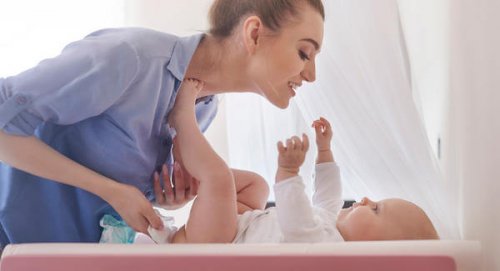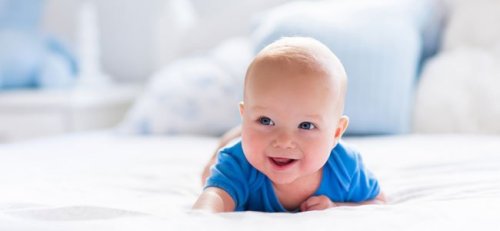The First Days of Your Baby's Physical Development

Babies are born with certain characteristics that will gradually change as they grow and develop. But what are the first days of a baby’s physical development like?
Newborn babies have rounded chests, relatively large heads, somewhat short extremities, and a prominent abdomen. They are about 50 centimeters long, and usually lie in a partially curled-up position. Their weight is usually around 3-4 kilograms, with boys weighing more than girls.
Areas of a Baby’s Development
A baby’s development is divided into various areas:
- Cognitive.
- Language.
- Physical, such as fine and gross motor skills.
- Social.
As the days pass we can watch how each of these develops.
The First Days of Your Baby’s Physical Development
Naturally, a baby changes in various ways as time passes. They aren’t just discovering the world around them, but also getting to know themselves bit by bit. Babies’ physical development starts at the head and extends to different parts of the body.
The Senses
In their first days of life, babies don’t know their bodies. In fact, they can’t tell where their own bodies end and their mothers’ begin.
Their vision is blurry and they can’t see clearly. Consequently, they can barely see shadows at a distance of half a meter.

Babies like having their attention captured with lights and sounds because this relaxes and amuses them. If your baby starts to get fussy, you can talk affectionately. It’s very important for babies to feel loved and protected to increase their sense of security.
Sleep
During the first month of life, babies spend very little time awake. They sleep most of the day – approximately 16 to 20 hours a day – and wake up only to eat.
It’s also normal for their breathing to be noisy and irregular while they are sleeping. Their sleep during the day can be interrupted every 2-3 hours for feeding.
Feeding
Pediatricians usually recommend breast milk as the only food for babies during the first month. If for some reason the mother can’t nurse her newborn, she can feed her baby using a bottle. No supplements are necessary, unless recommended by the pediatrician.
The Maternal Bond
Your baby will love being picked up and held. When you pick him or her up, be very careful with the head, which is very delicate. You can walk through different parts of the house with your baby so he or she can hear different sounds.
Babies can recognize their mother by smell, being held, and listening to the sounds of her heart. During this phase, babies discover that crying is their best resource for getting attention.
Weight
During the first weeks of life, your baby will probably not grow very much. It’s normal for a baby to lose weight during the first week, then gain weight again. By the end of the week, he or she will probably be at birth weight again.
Birth marks
It’s very common for a baby’s nose and head to be squished after birth. This is one of the consequences of passing through the pelvis during delivery.
Your baby’s eyes may be swollen and red as well. This will go away in a few days. You’ll also see the color of his or her skin become a more natural shade.

How Your Baby’s Fine Motor Skills Develop
There are several activities for babies between 0 and 4 months old that help their physical development and fine motor skills. This is directly related to their arm-mouth and eye-ear coordination.
- Let your baby bring objects that are not dangerous to his mouth and suck on them.
- Facing your baby, without obstructing his visual field, move your head, talk in different tones, and make different sounds. If your baby stops tracking the movement of your face, try to get his attention again.
- Put your finger in your baby’s palm so she can grab and squeeze it.
- Let your baby touch your face, hair, etc.
- When your baby drops a toy, let her pick it up.
- Start gently stroking the backs of your baby’s hands; when she opens her hands, take the opportunity to stimulate her palms with objects she can squeeze.
How to Develop Your Baby’s Gross Motor Skills
There are also activities for developing gross motor skills for babies from 0 to 4 months. Here are a few of them:
- Dress your baby comfortably. Don’t wrap him up too much so he’s free to move.
- Stroke his legs, arms, feet, and hands. This encourages movement.
- Change your baby’s position in the crib and gently rock him.
- With one hand on the baby’s calf and the other on his knees, gently flex and extend the legs into a horizontal position. Watch the position of the pelvis. The whole lumbar area should be supported on the surface that your baby is lying on.
- Let your baby put his hands in his mouth.
During your baby’s growth and development, he will be experiencing a variety of changes. It’s important to pay attention to each one. If you notice something unusual, consult your pediatrician.
All cited sources were thoroughly reviewed by our team to ensure their quality, reliability, currency, and validity. The bibliography of this article was considered reliable and of academic or scientific accuracy.
- Cloherty, J. Manual de Neonatología. Lippincott Williams & Wilkins, 2008.
- M. Cruz, M. Crespo, J. Brines, R. Jiménez. Compendio de Pediatría. Ciudad habana: ciencias Médicas; 2006.
- VV. AA. Desarrollo evolutivo de los neonatos: utilidad clínica de la escala Brazelton (NBAS). Actas do X Congresso Internacional Galego-Português de Psicopedagogia. Braga: Universidade do Minho, 2009 ISBN- 978-972-8746-71-1.
This text is provided for informational purposes only and does not replace consultation with a professional. If in doubt, consult your specialist.
